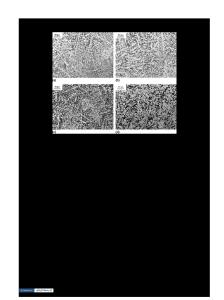Grain refinement effect of pulsed magnetic field on solidified microstructure of superalloy IN718
- PDF / 2,678,911 Bytes
- 8 Pages / 584.957 x 782.986 pts Page_size
- 73 Downloads / 319 Views
The refinement mechanism of pulsed magnetic field (PMF) was discussed by experimental investigation, and the effects of exciting frequency, exciting voltage, and delay time of PMF on grains refinement of superalloy were studied. The experimental results show that, as exciting frequency or exciting voltage is increased, the grains are refined. However, the grains become coarse when frequency increases further. As delay time of PMF increases, the grain size increases. The refinement effect of PMF is attributed to the detachment of heterogeneous nuclei on the mold wall and subsequently separation of nuclei in the melt. The Joule heat can prolong the continuous nucleation process. However, the refinement effect will be impaired if the Joule heat is strong enough to remelt the detached nuclei.
I. INTRODUCTION
The investment casting of a superalloy tends to produce coarse grains, which is favorable to the creep deformation property. However, in practice, many components are damaged because of high temperature fatigue. Therefore, it is desired to increase the ability against fatigue. The fatigue property can be effectively improved by grain refinement.1–3 Until now, new methods are still needed to refine as-cast microstructures of a superalloy more efficiently. Much attention has been given in recent years to solidified microstructures that can be refined by an electromagnetic field applied in the solidification process, which will improve the casting property. It is notable that electromagnetic vibration can significantly refine the solidified microstructure by superposing a static magnetic field and alternate magnetic field or alternate current.4–9 Recently, a pulsed magnetic field (PMF) was applied to aluminum refinement and showed significant refinement effect.10,11 The PMF can refine the casting microstructure of stainless steel.12,13 More recent research showed that a weak PMF can refine as-cast grains of magnesium alloy remarkably.14,15 The advantage of this method is the low exciting voltage of the PMF that can be easily used in practice. Although the weak PMF shows a significant refinement effect, the refinement mechanism needs further study. Theoretically, PMF might affect the nucleation and growth of nuclei to refine the solidified microstructure. It is widely accepted that the nucleation of the melt a)
Address all correspondence to this author. e-mail: [email protected] DOI: 10.1557/JMR.2009.0382
3174
http://journals.cambridge.org
J. Mater. Res., Vol. 24, No. 10, Oct 2009 Downloaded: 11 Mar 2015
is affected by thermal and convection conditions. Ohno and colleagues16,17 proposed that abundant heterogeneous nuclei are produced on the mold wall before the solidified shell is formed, and the nuclei can dissociate from the mold wall because of necked sharpening and mechanical fracture or thermal fluctuation. Furthermore, the melt convection can disperse the detached nuclei in the melt. According to the theory of Ohno et al., if we could enhance the nucleation on the mold wall and defer the formation of the so
Data Loading...











